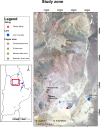Aquatic community structure as sentinel of recent environmental changes unraveled from lake sedimentary records from the Atacama Desert, Chile
- PMID: 32084252
- PMCID: PMC7034912
- DOI: 10.1371/journal.pone.0229453
Aquatic community structure as sentinel of recent environmental changes unraveled from lake sedimentary records from the Atacama Desert, Chile
Abstract
The Atacama Desert (21-26°S) is currently one of the driest places on Earth and metal(loid)s are of special concern for this region, which hosts the largest-known porphyry copper deposits produced in Chile. Evidence of past environmental conditions is commonly preserved in natural archives, such as lacustrine sediments. Sediment records obtained from Inca Coya Lake (22°20'S-68°35'W, 2534 m.a.s.l.), a small lake located in the Atacama Desert, reflected the evolution of regional mining activity during the 20th century and sedimentation associated with decadal climate variability. We studied the aquatic community structure changes recorded in sediment records from Inca Coya Lake. By analysis of magnetic properties (susceptibility, hysteresis curves and Curie temperatures), grain size and geochemical composition of the sediments, we identified environmental periods and changes in the community of benthic and planktonic organisms (diatoms and diapausing egg bank). We identified three detrital episodes that we interpret as dry/wet phases during the last 90 years associated with the increase of flash flood events promoting hypoxia oscillations; anthropogenic (mining activity) signals were also identified. Invertebrate community structure (primary consumers) reflected the metal exposure, measured as changes in assemblage composition through species turnover. Diatom community composition was best associated with variables related to wetter/drier alternation and consequent changes in oxygen availability. Bioindicators analyzed (diatoms, diapausing egg bank and invertebrate community) demonstrated to be excellent indicators of the bioavailability of compounds in the aquatic ecosystem of Inca Coya Lake, allowing the environmental impact assessment of the water resources due to flash floods and mining activity in the driest desert of the world.
Conflict of interest statement
The authors have declared that no competing interests exist.
Figures







References
-
- Antonovics J, Bradshaw AD, Turner RG. Heavy metal tolerance in plants. Adv. Ecol. Res. 1971; 7, 1–85.
-
- Keller W, Yan ND, Holtze K, Pitblado JR. Chemical response of acid lakes in the Sudbury, Ontario area to reduced smelter emissions, 1981–1989. Can J Fish Aquat Sci. 1992; 49 (Suppl.1): 25–32.
Publication types
MeSH terms
Substances
LinkOut - more resources
Full Text Sources
Miscellaneous

